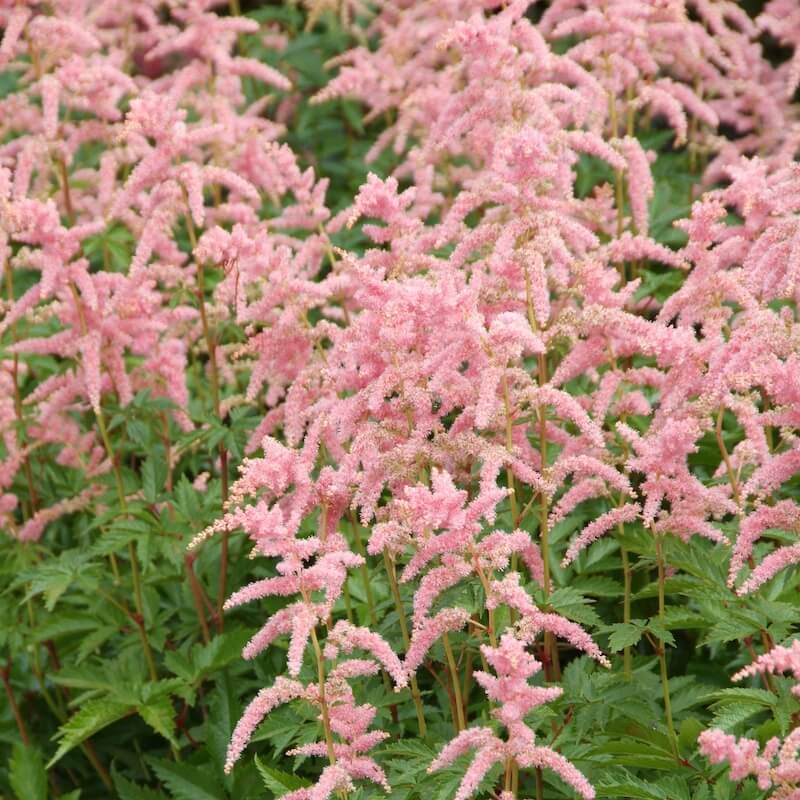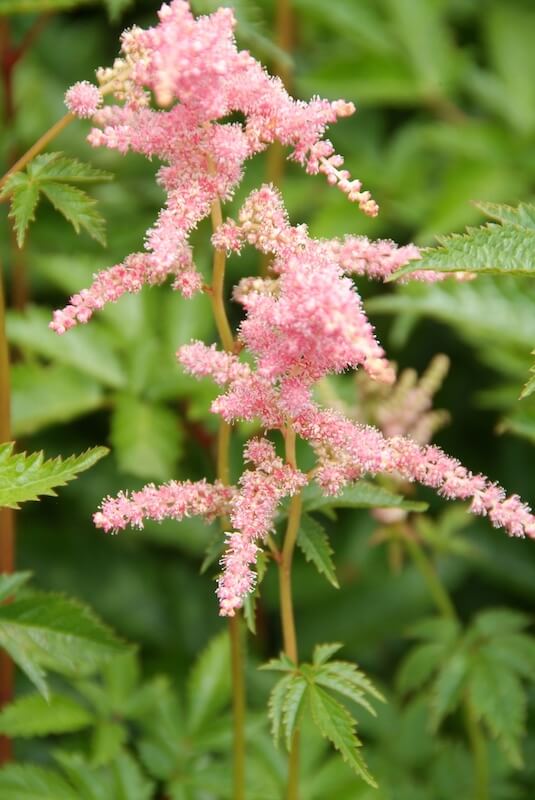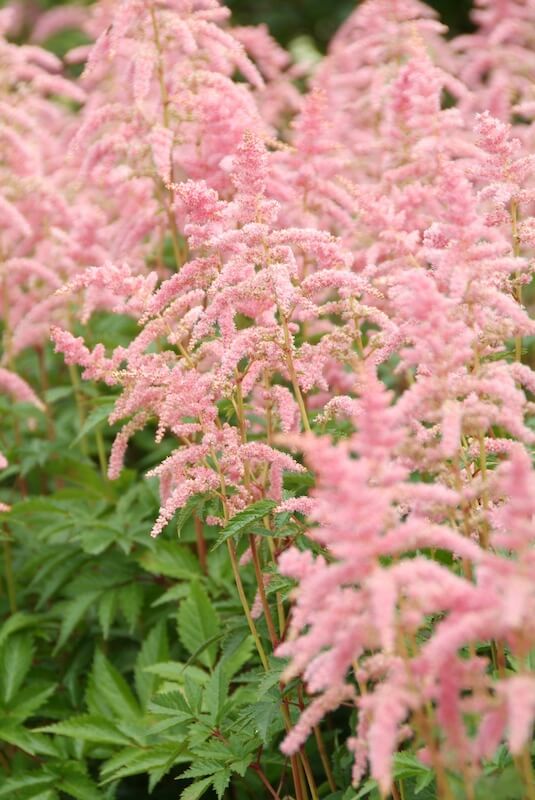Astilbe Bressingham Beauty - Graceful Plumes for Shady Spots
Astilbe arendsii Bressingham Beauty, Astilbe x arendsii Bressingham Beauty

Position
- Prefers partial shade but will tolerate full sun if the soil stays moist
- Well-suited for borders, woodland edges, alongside ponds, or in moisture-retentive areas of the garden
- Ideal for planting with other shade- or moisture-loving perennials such as hostas and ferns
Hardiness
- Hardy to around –20°C (–4°F)
- Performs reliably throughout the UK, coping well with typical winters
Soil
- Thrives in rich, moisture-retentive but well-drained soil
- Soil improvement with compost, leaf mould, or well-rotted manure is essential for healthy growth and long-lasting flower spikes
- Avoids dry or very sandy soils unless regularly watered and improved for moisture retention
- Adaptable to acid, neutral, or alkaline soils
- Very versatile as long as the soil holds moisture during the growing season
- Grab a soil test kit and ensure the perfect conditions for growth
Height
- Grows to around 90 cm (3 feet) tall in 5–10 years
- Forms a clump of upright, ferny foliage with tall, striking flower plumes
Seasons of Interest
- Foliage: Lush, divided, mid- to dark-green leaves from spring to autumn
- Autumn Colour/Variegation: Foliage may take on coppery tones before dying back in autumn; no variegation
- Flowering: Large, airy plumes of bright pink flowers are produced from late June to August
- Attractive to bees and pollinators, and excellent for cut flowers—both fresh and dried
Additional Notes
- Mulch in spring with compost or leaf mould to retain soil moisture and improve fertility
- Water freely during dry periods, especially when newly planted or in the sun
- Remove spent flower stems to tidy the plant, but the faded plumes can add winter interest if left
- Divide clumps every 3–4 years in spring or autumn if growth becomes congested
- Pest and disease resistant, and requires little maintenance
- Excellent for damp, shady borders and container plantings
Astilbe Bressingham Beauty - The Perfect Shade-Loving Perennial
Astilbe Bressingham Beauty is a garden star that shines in shady and damp corners. With its graceful, feathery plumes and vibrant colour, this reliable herbaceous perennial brings cheerful life to shady borders and woodland gardens. Whether you’re a seasoned gardener or just starting out, this plant offers structure, colour, and texture with very little fuss.
What is Astilbe Bressingham Beauty?
Astilbe Bressingham Beauty is a variety of astilbe bred for its bold performance and brilliant colour. The x arendsii group is known for vigorous growth and reliable flowering. Bressingham Beauty lives up to that reputation with its striking pink plumes and fern-like foliage.
It’s often called false goatsbeard astilbe or false spirea due to the fluffy, plume-like flowers that appear in midsummer. These feathery blooms stand tall on wiry stems, rising above mid-green leaves and forming a clump-forming, herbaceous perennial that returns each year with more presence.
The plant reaches a height of around 80–90 cm in flower, making it ideal for the middle of a shady border or alongside ornamental grasses. With consistently moist soil and some protection from hot sun, it will thrive and flower generously.
Where Should You Plant Astilbe Bressingham Beauty?
This astilbe thrives in a shady spot where the soil remains damp but not soggy. Think woodland edge, dappled light or the north side of a fence. It performs well in full shade or partial shade, and even tolerates full sun if the soil remains consistently moist.
It’s perfect for borders, waterside planting, or a spot near a pond where moisture is always present. Bressingham Beauty also works well in larger containers – just make sure the pot never dries out completely.
For best results, enrich the planting area with organic matter such as compost or well-rotted manure. Astilbes like soil that is rich, damp, and slightly acidic to neutral. Add a layer of mulch each spring to help the soil retain moisture and suppress weeds.

What Makes the Flowers of Bressingham Beauty So Striking?
The flowers are the true showpiece of this astilbe. From June to July, upright stems carry feathery plumes of vibrant pink flowers. These pink plumes seem to glow in shady light, adding structure and movement to the border.
Each plume is composed of hundreds of tiny flowers that open in succession, making the bloom period long-lasting and visually striking. They’re also popular with pollinators, drawing butterflies and other beneficial insects into the garden.
The combination of pink flowers with deeply cut green foliage creates a lovely contrast. You can pair it with other shade-loving perennials or allow it to stand tall against darker backgrounds for a bolder effect.
How Do You Care for Astilbe Bressingham Beauty?
Astilbes are wonderfully low-maintenance once they’re established. They need moist soil, a shady or partly shady spot, and a top-up of organic matter once or twice a year.
Water regularly in dry spells, especially in the first growing season. Astilbes hate drying out – drought can cause the leaves to become scorched and flowering to suffer. Use mulch to help the soil stay evenly moist.
Remove spent flowers once they fade to keep the plant tidy and encourage new growth. In late winter or early spring, cut back last year’s old stems before the new foliage appears. This tidy-up helps keep your plant fresh and vigorous year after year.
What Type of Soil is Best for Astilbes?
Moist soil is key. Astilbes grow best in soil that stays damp but not waterlogged. They thrive in rich, organic soil and dislike dry or overly sandy ground.
You can improve your soil by incorporating compost or well-rotted manure into the soil before planting. Heavy clay soils may require the addition of grit for improved drainage, while very dry soils should be enriched with water-retentive materials.
If your garden tends to dry out in summer, consider planting astilbes where they get some shade from the hot afternoon sun. This helps keep the soil from becoming too dry. A regular layer of mulch in spring will lock in moisture and feed the roots.
Why Choose Bressingham Beauty Over Other Astilbe Varieties?
Bressingham Beauty has several winning qualities. First, it produces tall, gracefully arching plumes of bright pink flowers that bring vibrancy and height to borders. Second, it is more tolerant of sun than many other astilbes as long as the soil is consistently moist.
This variety also has robust, dark green leaves that are deeply divided, providing a fine-textured background for the feathery blooms. Its strong, woody rhizomes form clumps that grow larger each year, making it ideal for long-term planting schemes.
Many gardeners find that Bressingham Beauty fills a gap where other perennials struggle, especially in damp, shady areas. It’s a perfect choice for cottage-style borders, woodland gardens, or shady spots under deciduous shrubs and trees.
Can Astilbe Bressingham Beauty Be Grown in Pots?
Yes, you can grow Bressingham Beauty in a pot, provided it receives enough moisture. Choose a generous container, at least 30–40cm wide, and use a compost rich in organic matter. A 9cm pot plant will eventually fill a large container or a border space.
Ensure the pot has good drainage, but don’t let it dry out. Check soil moisture regularly, especially during hot weather. Keep the pot in part shade or a spot with indirect light to avoid leaf scorch.
Feeding with a slow-release fertiliser in spring will support strong growth and flowering. Top up with mulch to reduce water evaporation and improve the compost over time.
When Does Astilbe Bressingham Beauty Bloom?
Bressingham Beauty blooms in midsummer, typically from June to July. Its long-lasting feathery plumes add impact for several weeks, especially when planted in groups.
You can extend the flowering season by combining it with other astilbe varieties that flower earlier or later. As one finishes, the next begins, keeping your shady borders full of colour from early summer to late summer.
Deadheading can help improve appearance, though it isn’t strictly necessary. Once flowering finishes, the spent blooms fade to dusty, papery spikes that still provide some visual interest.
Is Astilbe Bressingham Beauty Right for a Woodland Garden?
Definitely. Astilbes thrive in woodland gardens because they prefer moist, humus-rich soil and dappled or part shade. The feathery plumes and soft pink tones of Bressingham Beauty blend beautifully with ferns, hostas, and other shade-loving plants.
The deeply lobed, fern-like foliage pairs nicely with coarse-textured leaves and evergreen shrubs. Try planting it near a shady path or under deciduous trees where the soil stays damp in summer.
It’s also a great way to bring seasonal structure to woodland planting. The stems rise from a low clump, creating height and soft movement as they sway in the breeze.
How Can I Buy Astilbe Bressingham Beauty in the UK?
You’ll find this variety widely available at most reputable garden centres in spring and early summer. It’s also offered online by nurseries specialising in shade perennials. Look for healthy plants in 9cm pots or larger, and ensure that the roots are well-established.
When buying astilbe, choose firm, plump rhizomes or potted plants with signs of new growth. This ensures your plant is ready to establish quickly in the garden.
As a bonus, Bressingham Beauty holds a Royal Horticultural Society Award of Garden Merit (RHS AGM), which marks it as a reliable, top-performing choice for UK gardens.
From Darren’s Patch
Astilbe Bressingham Beauty has become an absolute mainstay in my shady borders. It’s one of those perennials that just gets on with the job — no fuss, no drama, just generous plumes of pink that light up even the gloomiest corner. I’ve planted it near a shady seating area, and by midsummer, those tall, feathery blooms always catch the eye and bring the whole spot to life. It copes well in damp conditions where others might fail, and once established, it needs very little from me apart from the occasional mulch and a trim back in early spring. It’s also brilliant for softening the edges of a pond or pathway. If you’ve got tricky, moisture-retentive soil and a bit of dappled shade, this is a plant I’d wholeheartedly recommend — it never disappoints.
![]()
Key Points to Remember
- Plant in partial shade, full shade, or dappled light
- Keep soil consistently moist – water in dry spells
- Enrich soil with compost, manure, or other organic matter
- Mulch in spring to conserve moisture and feed the roots
- Choose well-drained but damp soil that won’t dry out
- Tolerates full sun if the soil stays moist
- Blooms in midsummer with bright pink plumes
- Works beautifully in borders, woodland gardens, and containers
- Deadhead to tidy up, or leave papery flowers for texture
- Cut back in late winter or early spring to encourage fresh new growth
- An excellent addition to shady spots and a pollinator-friendly choice
Astilbe Bressingham Beauty thrives in partial shade with moist, well-drained soil of any pH and is hardy to –20°C (–4°F). Growing up to 90 cm (3 ft) after 5–10 years, it forms a dense clump of divided green foliage and produces showy, bright pink flower plumes from late June to August. With annual mulching, regular watering and occasional division, it’s a reliable choice for colourful, long-lasting summer borders and damp garden areas in the UK.
Check out the RHS article here.
If you like this one, you’ll love Anthemis Sauce Hollandaise. Click here to explore it.
For more information on perennials for your garden, please click here.

Frequently Asked Questions
Q: What is Astilbe Bressingham Beauty, and why is it a popular garden plant?
A: Astilbe Bressingham Beauty is a striking herbaceous perennial admired for its vibrant, feathery pink plumes and lush fern-like foliage. It’s a clump-forming plant that thrives in partial shade and consistently moist, fertile soil. Ideal for woodland gardens, borders, or waterside planting, this false goatsbeard astilbe adds texture and colour during midsummer when its plume-like flowers emerge. Its tolerance for damp, shady conditions makes it an invaluable choice for tricky garden spots. Loved for both its ornamental qualities and pollinator appeal, this variety is a staple for those seeking a graceful yet low-maintenance perennial.
Q: Where is the best place to plant Astilbe x arendsii Bressingham Beauty in the garden?
A: For best results, plant Astilbe x arendsii Bressingham Beauty in partial shade to full shade, where it’s protected from hot afternoon sun. It thrives in evenly moist, well-drained soil rich in organic matter. A dappled or shady spot near shrubs, trees, or along woodland paths is ideal. This plant is particularly suited to the shaded edge of a border or waterside setting where the soil remains consistently damp. Avoid areas that dry out, as astilbes are not drought-tolerant and may become scorched in dry or exposed conditions.
Q: How do I care for Astilbe Bressingham Beauty throughout the year?
A: Astilbe Bressingham Beauty requires little maintenance once established. Keep the soil consistently moist, particularly during dry spells in summer. Apply a mulch of organic matter in late winter or early spring to retain moisture and improve soil structure. Feed in spring with a balanced plant feed to support healthy growth and flower development. After flowering, the plumes can be left to add autumn interest or cut back for tidiness. In late winter, remove old stems and faded foliage to make way for new growth. Astilbe benefits from being divided every few years to maintain vigour.
Q: Can Astilbe x arendsii Bressingham Beauty be grown in pots or containers?
A: Yes, Astilbe x arendsii Bressingham Beauty can thrive in containers, provided the conditions mimic its natural preference for moisture. Use a deep pot filled with moisture-retentive compost and position it in a partially shaded location. Regular watering is essential, especially during warm weather, to prevent the soil from drying out. Adding water-retaining gel or using a saucer to catch excess moisture can be helpful. Feeding in spring and again in midsummer with a liquid feed will encourage vibrant flowering. Container-grown astilbes are perfect for patios, shady corners, and small spaces.
Q: When does Astilbe Bressingham Beauty flower, and what does it look like?
A: Astilbe Bressingham Beauty produces its showy blooms in midsummer, typically from June to July. The plant features tall, gracefully arching plumes of bright pink flowers made up of tiny florets that create a soft, frothy effect. These vibrant plumes rise above mid-green, fern-like foliage, adding vertical interest to shady borders. The flower spikes are held on sturdy stems and can reach up to 90cm in height, making them ideal for adding drama and texture to garden displays. Their long-lasting presence also makes them excellent as cut or dried flowers.
Q: Is Astilbe x arendsii Bressingham Beauty suitable for wildlife and pollinators?
A: Absolutely. Astilbe x arendsii Bressingham Beauty is an excellent plant for attracting pollinators, especially bees and butterflies. Its open, feathery blooms are rich in nectar and provide an accessible food source during midsummer when many pollinators are most active. Planting astilbes in clusters within a woodland or shaded garden encourages beneficial insects and supports local biodiversity. Pairing with other pollinator-friendly perennials helps create a garden that is both beautiful and ecologically supportive.
Q: Can Astilbe Bressingham Beauty tolerate full sun or dry conditions?
A: While Astilbe Bressingham Beauty can tolerate some morning sun, it performs best in partial to full shade with evenly moist soil. In full sun, especially without adequate moisture, the foliage can become scorched, and the blooms may fade prematurely. Dry conditions or drought can lead to wilting and poor flower production. To keep your astilbe healthy, ensure the planting site retains moisture and avoid areas that become dry or dusty. A shady, damp border or woodland-style garden will offer the ideal environment for this variety to thrive.
Q: How should I divide or propagate Astilbe Bressingham Beauty?
A: Astilbe Bressingham Beauty should be divided every 3–5 years to rejuvenate the plant and maintain strong flowering. The best time to divide is in early spring or autumn. Gently lift the clump using a garden fork and separate the woody rhizomes into smaller sections, ensuring each piece has several healthy shoots and roots. Replant immediately into moist, well-prepared soil and water thoroughly. Division not only helps to control the plant’s size but also encourages new, vigorous growth and prolongs the life of your astilbe in the garden.
Q: Where can I buy Astilbe x arendsii Bressingham Beauty?
A: Astilbe x arendsii Bressingham Beauty is widely available at UK garden centres, specialist nurseries, and from trusted online retailers. Look for strong, healthy plants with rich green foliage and well-developed root systems, often supplied in 9cm pots or larger. Buying from reputable sources ensures you receive high-quality plants that will establish quickly and perform well in your garden. It’s a popular choice among shade-loving perennials, so availability is generally good during the spring and early summer planting season.
